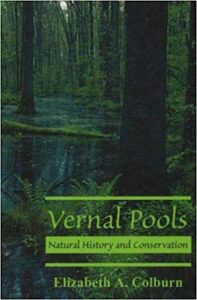 To anyone who has ever stumbled across one while strolling through a woodland, vernal pools seem to border right on the edge of magical. Disconnected as they are from other water sources, there’s something so remarkably serene about them that they almost beggar belief. And when the dappled light filtering through the trees is added to the experience, one wouldn’t be entirely surprised should one of the faerie folk suddenly appear out of the greenery just across the pond.
To anyone who has ever stumbled across one while strolling through a woodland, vernal pools seem to border right on the edge of magical. Disconnected as they are from other water sources, there’s something so remarkably serene about them that they almost beggar belief. And when the dappled light filtering through the trees is added to the experience, one wouldn’t be entirely surprised should one of the faerie folk suddenly appear out of the greenery just across the pond.
However aside for their mythopoetic powers, vernal pools are remarkably important to the forest ecosystems in which they appear. Many species have life cycles that rely on them, and a host of others are benefited to a greater or less degree by their presence. The problem is that as they are ephemeral in their own cycles of existence, they are often overlooked even by experienced naturalists.
This oversight can be remedied by Elizabeth Colburn’s Vernal Pools; Natural History and Conservation. Originally published in 2004, it recently came to my attention at The Wildlife Society‘s annual meeting in Cleveland, Ohio this past summer thanks to the display set-up there by the book’s publisher McDonald & Woodward. The first book to take up the subject of the ecology of these fascinating phenomena, Vernal Pools still stands as the only comprehensive overview of their natural history, ecology, and conservation, and as such, it’s well worth investigating by any and all interested in forest ecology (as well as mythology, for that matter).
If you enjoyed reading this, please consider signing up for The Well-read Naturalist's newsletter. You'll receive a helpful list of recently published reviews, short essays, and notes about books in your e-mail inbox once each fortnight.
